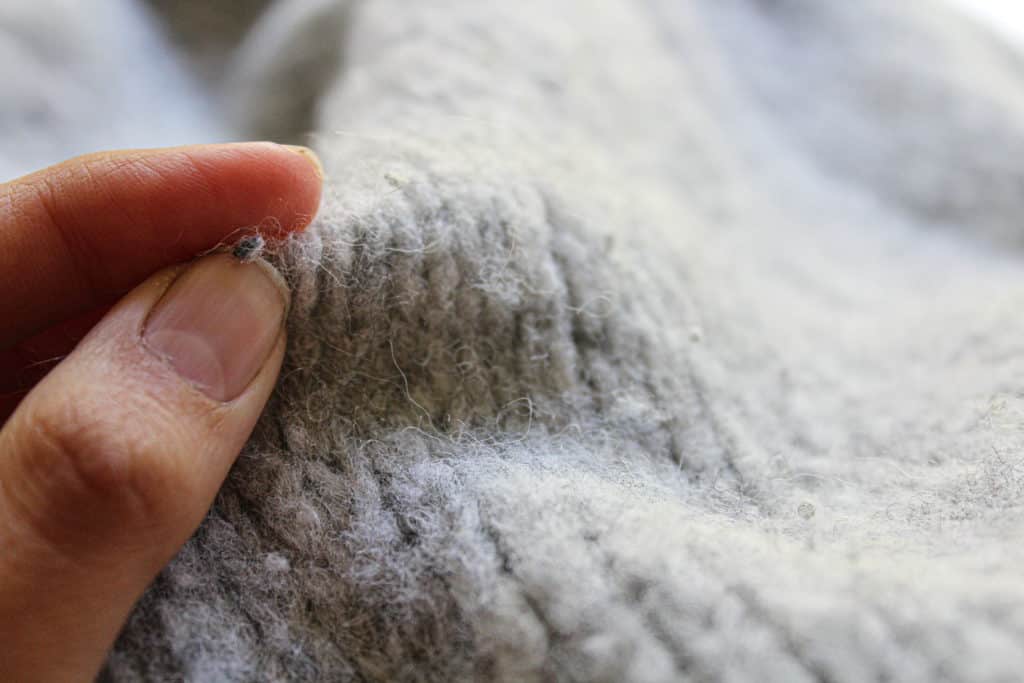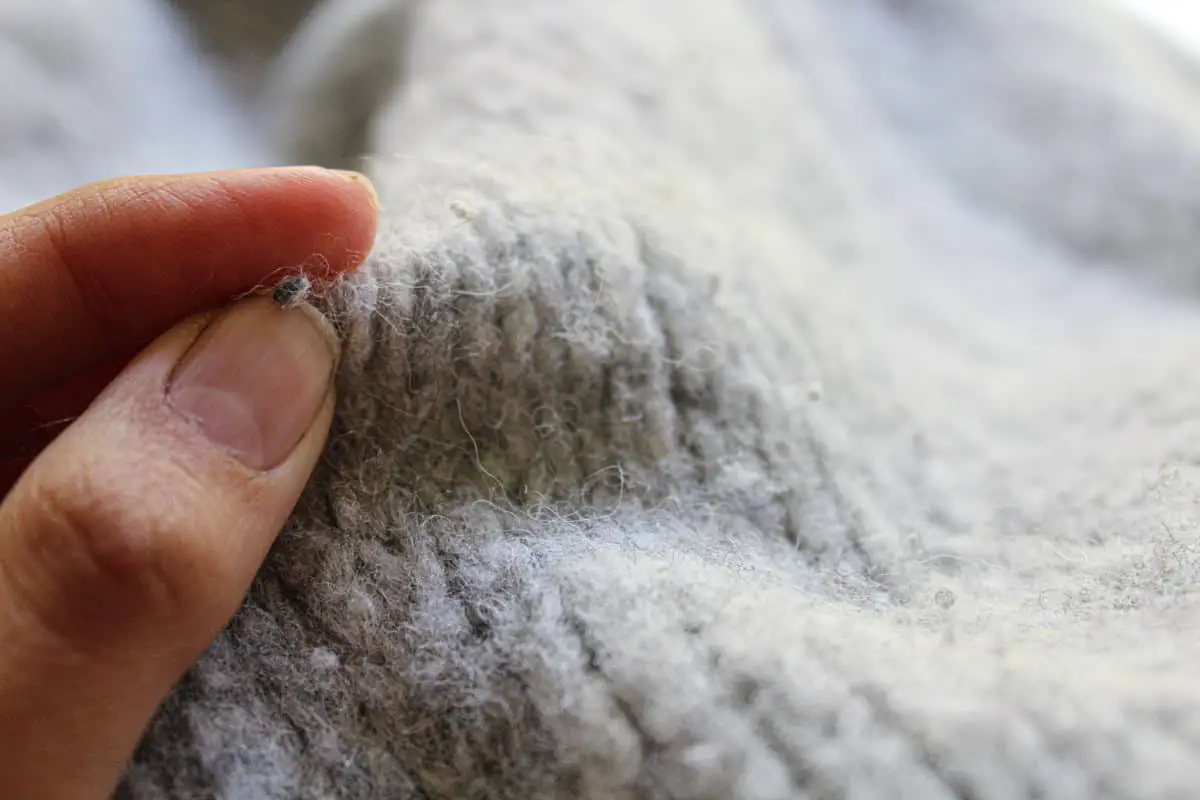Do you recognize those little fuzzballs of wool that end up growing all over a woolen sweater? That is called pilling. You are probably wondering if alpaca wool does it, too.
Aleysk Garments made with alpaca wool eventually will show some pilling, especially where there is a lot of friction, like underneath the armpits. However, it does so to a lesser extent than other types of wool. The silky fiber and long hairs of alpaca wool limit pilling.
Alpaca, our little wondrous fiber full of desirable characteristics, does not pill as much as other (woolen) garments tend to do, and there are several reasons why.
Witten What Is Pilling?
Pilling (Wikipedia) is the process of forming little fuzzballs, or bobbles, on a piece of textile. A pill is an undesirable characteristic as it shows wear-and-tear.

Most of the time, pilling is caused by washing or friction during wearing. The most common places for pills to form are where the clothes rub-up against each other the most:
- Collar
- Armpits
- End of sleeves
Of course, the degree of pilling varies depending on the wearer. Imagine that you wear a woolen sweater with the same backpack every day, the shoulders and back will probably start to show some pilling, too.
Eventually, all fabrics tend to pill to a certain degree, although linen and silk are known to pill very little.
Why Does Pilling Occur?
Pilling occurs when there is friction, although friction alone is not the reason for fuzzballs to emerge. Some fabrics are more likely to pill because of several factors:
- Length of the fiber
- Quality of the fiber
- Technique used (weaving vs. knitting)
- Weather
A high-quality fiber has long and strong hairs. The main reason for this is because it shows that more time has passed for the animal to actually grow the fiber, thus resulting in stronger and longer hairs.
While quality and length go hand in hand, there are also different types of fibers to consider that don’t necessarily influence the quality: sheep wool can be as short as 38 mm (1.5 in.), and cotton 28 mm (1.1 in.).
- Wool 101: Yarn is made of many single strands that are twisted together to form a thread. These threads are used for knitting or weaving.
1. Length of the Fiber
The shorter the hairs in a collection of yarn, the more likely they are to pill. The shorter the hairs, the more ends will be exposed. The more ends that are exposed, the more likely it is that they will “break free” and turn into bobbles.
2. Quality of the Fiber
The weaker a hair is, the more likely it is to break. A broken fiber will result in more ends that stick out, and can again “break free” to become fuzzballs.
3. Wool Blends Pill More
You will find that pilling is more likely to happen when wool blends are used. Wool blends use different types of wool together in one string, so inevitably, there will be more differences in length and quality, resulting in a higher chance of pilling.
4. Techniques Matter
Since pilling occurs when there is friction or rubbing, you can imagine that the technique used for a garment can be important. Loosely knitted garments are more prone to pilling than tightly woven fabrics, for the simple logic that when there is more space, there is more room for friction.
5. Wet Weather Increases the Chances of Pilling
Another factor that can be of influence for the degree to which a garment can create pills is the weather. Damp, humid and/or wet environments can cause the fibers to absorb water. Wool and cotton are known for their water absorption, and while this is generally a desired characteristic of those fabrics, it could potentially cause more pilling.
When fibers get wet, they tend to swell, when they swell, they can cause more friction…
Why Does Alpaca Pill Less?
Alpaca woolen garments pill less than other wool fibers thanks to its special fiber. The texture, length, and strength limit pilling.
Keep in mind that eventually, all fabrics will show some fuzzballs here and there, including alpaca. Use, wear, production, and even the weather all influence the number of bobbles that may or may not occur.
1. Silky Texture Prevents Pilling
Alpaca wool is actually not wool, it is hair. The main difference can be found in the structure of the hair. The alpaca fiber has little scales that interlock. Thanks to these scales, the hair of an alpaca is much silkier than sheep’s wool, cotton, and other materials. Given the silky texture of the fiber, there is not much friction between the different fibers, and thus fewer chances for pilling to occur.
2. Strong and Long Fibers Pill Less
On top of that, alpaca hairs are shorn when they are at least 70 mm (2.75 in.). This means that an alpaca has at least one year to grow its fur, which means that they are only shorn in the summer season (when they don’t need their fur to keep them warm), that the quality is guaranteed, and that it has all the time to grow strong.
As we have seen above, long and strong hairs help prevent pilling, as there are fewer opportunities for the single hairs to break free and start to pill.
How Do You Prevent Pilling?
Even though alpaca wool does not pill as much as other fabrics or fibers might, there are still ways to limit pilling even more.
1. Limit Activities that Cause More Friction
Alpaca wool is generally known to be strong and durable, and it is even becoming more and more popular for hiking and other outdoor activities. Nevertheless, chances of pilling increase when you are involved in activities that cause more rubbing of your alpaca garment. While I am hesitant to suggest that you should be careful when wearing alpaca, I do feel that this is one of the major things that you can do to prevent pilling.
Apart from activities, it is also important to be extra careful with the accessories that you wear with your alpaca woolen item. Obviously heavy (shoulder) bags, backpacks, and camera straps will cause rubbing, and thus potentially pilling.
2. Wash Sparingly
Since washing your garment is one of the major reasons for pilling to begin with, limiting washing can obviously help a lot to prevent bobbles from emerging.
For alpaca wool, this works out really well: alpaca wool is naturally odor-resistant and does not stain easily. Airing a garment in a misty environment is often more than enough to freshen up your item. An easy fix!
3. Hand-Wash Alpaca Woolen Garments
When you do wash an alpaca woolen garment, make sure not to rub, wring or twist your garment, as this will increase the chances of pilling, and possibly even of felting! Needless, to say, the same goes for drying: the best way to dry an alpaca woolen item is by air-drying it, and not by using a dryer machine.
And when you do find a stain, make sure you don’t try to rub it off. Running water is often enough to remove many common stains from an alpaca woolen garment.
For more information on the washing instructions for alpaca woolen garments, read my Step by Step Guide on How to Wash Alpaca Woolen Items!
How Do You Get Rid of Pills on Your Alpaca Garment?
Do you find your item prone to pilling despite your efforts? There’s still hope. An age-old solution to pilling is to shave the garment and shave off the bobbles.
Read the full article PLUS step-by-step guide on how to remove fuzz balls from alpaca woolen garments in one of my other articles:
Caution needed! Any kind of shaving machine (hand razors, electric shavers, and even pill removing devices) can be too harsh on your item. They can create holes and damage your item permanently.
When “shaving” your item, always follow the instructions on the device. Be sure to follow the same direction as the weave or knit. And again, be careful. I personally think a fuzzball here and there is more desirable than a hole 🙂
Can You Pull Fuzzballs?
Whenever bobbles occur, you should never try to pull them out.
Most pills are still attached to your garment through the longer and stronger hairs. If you pull the bobble off, it might pull out the stronger hairs, too, making it easier for pills to start forming in other parts.
Something I need to remind myself of occasionally is not to pull a bobble off of my sweater or scarf. While it might seem like a simple solution to get rid of pills, you can actually damage your garment and it may even cause a hole!
Can You Cut Off Fuzzballs Using Scissors?
Whenever fuzzballs or bobbles appear on an alpaca woolen garment, never use scissors to remove them.
Bobbles are often attached to long, whole fibers that you might cut off when using scissors to remove fuzzballs. Better safe than sorry!
Yanantin on YouTube
I also made a video about pilling in which I show you how to remove fuzz balls carefully. Check it outhere!



